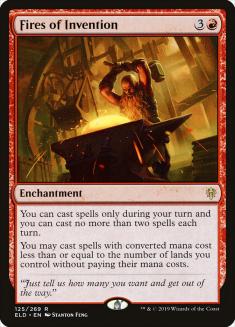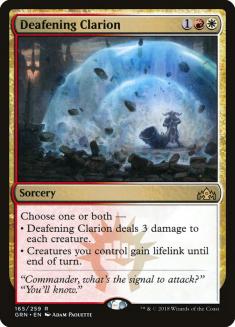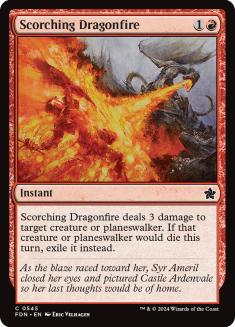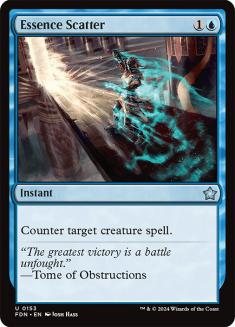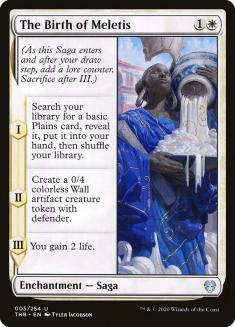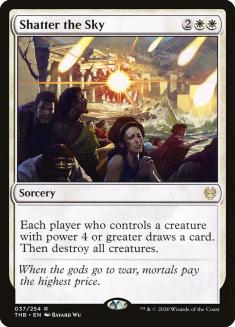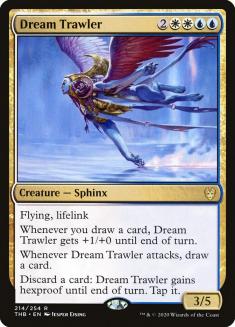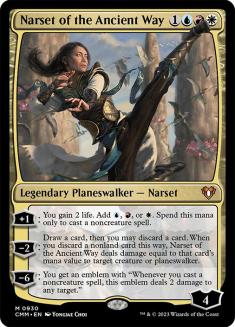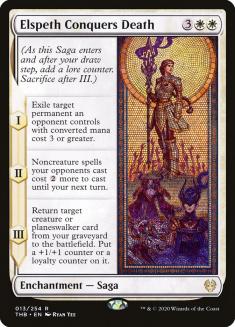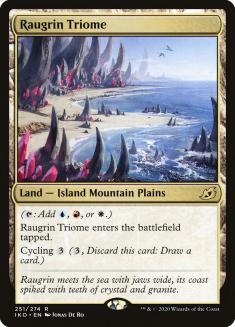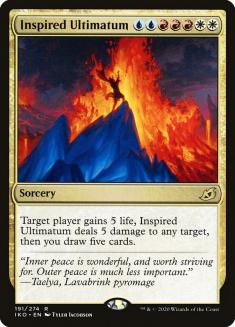Playing a traditional control deck in Ikoria Standard will yield results in the age of companions. Due to companions’ restrictive natures, a control deck can adapt its maindeck and sideboard to tackle the specific metagame spawned from this new mechanic.
I’m not as doom-and-gloom as many of my colleagues here, though I’m far from naive. Starting with an eight-card hand is worth nearly every cost attached from the first wave we have seen in Ikoria. There are decks that continue to be successful without them, which is why I have been a staunch advocate of the Sultai Control deck I released last week.
If control players wish to engage in the companion game, the list to choose from is very small. Outside of an extreme rogue strategy, Yorion, Sky Nomad will be the champion of the archetype. This is a very good thing, because I would argue that the ability, size, evasion, and cost of including this companion is the greatest out of the bunch.
The world has been in panic mode with Lurrus of the Dream-Den dominating the older formats and giving us a scare in Ikoria Standard. The cost of including Lurrus in Modern, Pioneer, or Legacy is comically low, making it a legitimate problem for these formats. In Ikoria Standard, it spooked me enough to get me to heavily gear my control decks to defeat aggro, when I should have known better.
Standard has been dominated by big mana, midrange, and control for some time now. There have been quick flashes of power from Mono-Red Aggro, Rakdos Sacrifice, and other aggro strategies, but slow decks rose to the top. This was thanks to developmental mistakes from the Simic guild, which we are still paying for. Even after banning a couple of cards, it still had problematic spells left over, including the release of Uro, Titan of Nature’s Wrath. Until the next large rotation, Simic will comfortably stand at the top of the format. The puzzle I have been trying to solve is determining which decks can hang with them, while also fending off the best aggro decks of the format. Solving that will give you a control deck that will take you across the finish line in competitive play.
Creatures (7)
Planeswalkers (4)
Lands (27)
Spells (22)

Sultai Control is still a fine choice moving forward, as it includes many of the best cards in the format. The glaring issue is the lack of companion, which takes us back to the minimal cost of Yorion. Sultai Control can adapt this companion but does not have the same tools as some alternative deck choices to take full advantage of the ability. At this point, I will start to work twenty more cards into Sultai Control because even if the ability doesn’t always hit, it’s still a viable five-drop in any control shell.
The deck that takes full advantage of Yorion? Yorion Jeskai Control.
Creatures (2)
Planeswalkers (11)
Lands (34)
Spells (33)

Yorion Jeskai Control is primed for an Ikoria Standard breakout. Unlike Sultai Control, the bombshells of Azorius get right back into the game. It was not long ago that Azorius Control ran the competitive streets, making Jeskai Control immediately viable. There is a lot of hype and success behind Fires of Invention, which is basically a beefy Jeskai Midrange deck, but the penalty for including that enchantment is far too high for me to get behind in the current metagame.
Fires of Invention prevents the instant-speed interaction that makes control special and requires a heavy curve to take full advantage of the ability. This avenue forces the deck to be fully proactive, often losing any edge that these powerful interactive spells provide. The counterspells are decent enough in Ikoria Standard to get behind and trump the midrange attempts at jamming threats. I have always enjoyed playing against Fires of Invention with all of my control decks for that very reason and this version of Yorion Jeskai Control takes it down regularly.
Although my other control concoctions have treated me well, this one has been a home run. With the remaining aggro decks being susceptible to Deafening Clarion, Scorching Dragonfire, Essence Scatter, and The Birth of Meletis, the rest of the deck can be dedicated to handling the slower half of the metagame. Even these anti-aggro cards have huge applications against the rest of the field they were not meant to answer.
Deafening Clarion is the least impressive of the bunch, but not useless. It has that exact damage infliction that can take out an army of lands created by Nissa, Who Shakes the World. That alone gives it a leg to stand on, but its supporting staff has really overperformed.
Scorching Dragonfire hits planeswalkers as well, something that I missed on my first review of the spell, and that’s huge. When I started using it during the previews and discovered that secondary target, I knew red had a chance to represent the control family soon. Removal spells that just hit creatures are necessary but can produce some feel-bad moments when playing against decks without targets. Scorching Dragonfire always has a planeswalker to hit when the battlefield is not festering with monsters and puts the fear of activation in each opponent. One use of a Teferi, Time Raveler or Narset, Parter of Veils is a death sentence for each against Yorion Jeskai Control.
I knew Essence Scatter and The Birth of Meletis would have strong application against every deck in the format. Each player is using creatures now, including staunch reactive control players who have historically refused. Dream Trawler and Uro are both too good to exclude when in the appropriate colors, which Azorius Control and Temur Reclamation both admit. Having access to a powerful counterspell that works against every deck in the format is a game-changer. Essence Scatter, along with all its counterspell buddies, will be a format staple in the companion-based world we all now live in.
The Birth of Meletis is one of those cards in Standard that I try to always play. I have written extensively on the importance of land drops, which may sound like an obvious necessity. All decks want to hit their land drops, but control decks typically lose on the spot when they miss an early one. This is one of the scariest aspects to control for players who try it for the first time. The upside used to be the late-game dominance, even through intense flooding. Drawing too many lands was more of an issue for non-control decks, due to the wonderful mana sinks at our disposal. These days, other archetypes have creative ways to use their excess mana in the late-game, but control still has the mightiest plays to execute with their twelfth land. The Birth of Meletis provides that beautiful land, a blocker, and a couple of points of life for the cost of two mana. If my deck has white in it, it will have this enchantment.
The twenty extra cards we are forced to play to use Yorion have helped my cutting woes for Yorion Jeskai Control. Four sweepers are concerning, leaning heavily on the back of Shatter the Sky, so in comes Deafening Clarion to the rescue. That gives this deck seven sweepers to start the match off. Even though there are twenty more cards to sift through, the number of sweepers has made it a breeze to destroy low-cost threats in the early-game. I know it is not as efficient as its 60-card predecessors, but this has been Magical Christmas Land for control brewers these last few weeks.
There are always concessions in deckbuilding with win conditions, even when we get to play with 80 cards. The two copies of Inspired Ultimatum have been magnificent in this slower format and are included over additional copies of Dream Trawler. In traditional Azorius Control, I would still include at least three copies of Dream Trawler to make full use of Elspeth Conquers Death and have a guaranteed win condition on the battlefield on my sixth turn. The game changes with Yorion Jeskai Control, with access to additional targets to return to the battlefield from the graveyard.
Narset of the Ancient Way has been as good as I predicted prior to release. I knew it would be a good curve addition to the four-slot, much better than Elspeth, Sun’s Nemesis in the current metagame. My original Yorion Jeskai Control lists had a couple of copies of Elspeth, Sun’s Nemesis in it, due to the aggro wave we faced right off the bat. If Lurrus or other aggro decks take back the mantle, then there will be a split of these four-drops. For the time being, Narset of the Ancient Way provides an opportunity for a stellar series involving early interaction and it arriving to Vindicate the sole threat on the battlefield. It happens more often than I anticipated and it’s due to the powerful early-game spells that I mentioned before.
When the best companion mandated all permanents should cost two mana or less, Elspeth Conquers Death was a bit awkward to get behind. With that reality shattered and many players leaning on four-mana enchantments, Elspeth Conquers Death returns to full form. What this means for control players is that decks should be white-based, as this is the best answer to nearly everything with tremendous upside. Dream Trawler is great and all, but Elspeth Conquers Death is again the best card control has in its arsenal. The icing on the cake is that it requires us to play a bunch of planeswalkers to bring back, which is how control should be played!
Raugrin Triome is the only reason Yorion Jeskai Control works. I have joked a bit about having Esper Control withdrawals and that feeling will continue until the mana is improved. Any three-color deck is viable with all these shocklands and Temples, but the consistency suffers. If there are powerful options for control decks that have an on-color Triome, I will be leaning in that direction. One of the big motivating factors is Inspired Ultimatum, which has been a blast to use.
Inspired Ultimatum is one of those cards that begs for a slower format, providing a huge swing in card advantage. The five life that’s attached makes it an acceptable maindeck card even when there are some aggro decks still lurking around. In a format dominated by battlefield presence and card advantage, Inspired Ultimatum can singlehandedly deliver a win on Turn 7. Control does not need to deal lethal damage with it, but answering a large threat, returning to the starting life total, and drawing five cards can be good enough to move on to the next game. This haymaker of a spell can leap into action on-time with the help of cycling, The Birth of Meletis, Narset of the Ancient Way, and Omen of the Sea, guaranteeing smooth land sequencing.
Yorion is the best companion in Ikoria Standard and that’s showcased here. For the restriction attached, this monster with evasion provides card advantage and a threat that can always arrive on Turn 5. Having eleven planeswalkers and eleven enchantments to target is the core of its strength, especially in those games where the curve cooperates.
I was skeptical of a companion that required a twenty-card injection for use when it was previewed, but quickly learned that it was the least we could offer for its service. We have all heard the gripes about companions, many of them justified, but it will be Yorion that crushes Ikoria Standard with uniformity.
I do not see anyone veering off the path of this companion when building their next three-color deck.





